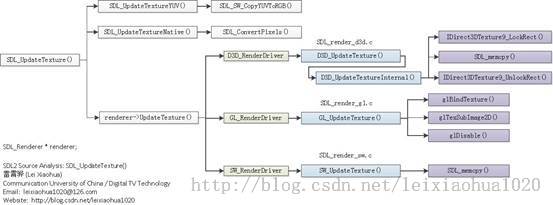SDL2源代码分析5:更新纹理(SDL_UpdateTexture())
=====================================================
SDL源代码分析系列文章列表:
SDL2源代码分析1:初始化(SDL_Init())
SDL2源代码分析2:窗口(SDL_Window)
SDL2源代码分析3:渲染器(SDL_Renderer)
SDL2源代码分析4:纹理(SDL_Texture)
SDL2源代码分析5:更新纹理(SDL_UpdateTexture())
SDL2源代码分析6:复制到渲染器(SDL_RenderCopy())
SDL2源代码分析7:显示(SDL_RenderPresent())
SDL2源代码分析8:视频显示总结
=====================================================
上一篇文章分析了SDL的创建纹理函数SDL_CreateTexture()。这篇文章继续分析SDL的源代码。本文分析SDL更新纹理数据函数SDL_UpdateTexture()。
SDL播放视频的代码流程如下所示。
初始化:
SDL_Init(): 初始化SDL。循环渲染数据:
SDL_CreateWindow(): 创建窗口(Window)。
SDL_CreateRenderer(): 基于窗口创建渲染器(Render)。
SDL_CreateTexture(): 创建纹理(Texture)。
SDL_UpdateTexture(): 设置纹理的数据。上篇文章分析了该流程中的第4个函数SDL_CreateTexture()。本文继续分析该流程中的第5个函数SDL_UpdateTexture()。
SDL_RenderCopy(): 纹理复制给渲染器。
SDL_RenderPresent(): 显示。
SDL_UpdateTexture()
函数简介
SDL使用SDL_UpdateTexture()设置纹理的像素数据。SDL_UpdateTexture()的原型如下。int SDLCALL SDL_UpdateTexture(SDL_Texture * texture,
const SDL_Rect * rect,
const void *pixels, int pitch);
参数的含义如下。
texture:目标纹理。
rect:更新像素的矩形区域。设置为NULL的时候更新整个区域。
pixels:像素数据。
pitch:一行像素数据的字节数。
成功的话返回0,失败的话返回-1。
函数调用关系图
上面的图片不太清晰,更清晰的图片上传到了相册里面:
http://my.csdn.net/leixiaohua1020/album/detail/1793769
源代码分析
SDL_UpdateTexture()的源代码位于render\SDL_render.c中。如下所示。
int SDL_UpdateTexture(SDL_Texture * texture, const SDL_Rect * rect,
const void *pixels, int pitch)
{
SDL_Renderer *renderer;
SDL_Rect full_rect;
CHECK_TEXTURE_MAGIC(texture, -1);
if (!pixels) {
return SDL_InvalidParamError("pixels");
}
if (!pitch) {
return SDL_InvalidParamError("pitch");
}
if (!rect) {
full_rect.x = 0;
full_rect.y = 0;
full_rect.w = texture->w;
full_rect.h = texture->h;
rect = &full_rect;
}
if (texture->yuv) {
return SDL_UpdateTextureYUV(texture, rect, pixels, pitch);
} else if (texture->native) {
return SDL_UpdateTextureNative(texture, rect, pixels, pitch);
} else {
renderer = texture->renderer;
return renderer->UpdateTexture(renderer, texture, rect, pixels, pitch);
}
}
从源代码中可以看出,SDL_UpdateTexture()的大致流程如下。
1. 检查输入参数的合理性。例如像素格式是否支持,宽和高是否小于等于0等等。
2. 如果是一些特殊的格式,进行一定的处理:
a) 如果输入的像素数据是YUV格式的,则会调用SDL_UpdateTextureYUV()进行处理。3. 调用SDL_Render的UpdateTexture()方法更新纹理。这一步是整个函数的核心。
b) 如果输入的像素数据的像素格式不是渲染器支持的格式,则会调用SDL_UpdateTextureNative()进行处理。
下面我们详细看一下几种不同的渲染器的UpdateTexture ()的方法。
1. Direct3D
Direct3D 渲染器中对应UpdateTexture ()的函数是D3D_UpdateTexture(),它的源代码如下所示(位于render\direct3d\SDL_render_d3d.c)。static int
D3D_UpdateTexture(SDL_Renderer * renderer, SDL_Texture * texture,
const SDL_Rect * rect, const void *pixels, int pitch)
{
D3D_TextureData *data = (D3D_TextureData *) texture->driverdata;
SDL_bool full_texture = SDL_FALSE;
#ifdef USE_DYNAMIC_TEXTURE
if (texture->access == SDL_TEXTUREACCESS_STREAMING &&
rect->x == 0 && rect->y == 0 &&
rect->w == texture->w && rect->h == texture->h) {
full_texture = SDL_TRUE;
}
#endif
if (!data) {
SDL_SetError("Texture is not currently available");
return -1;
}
if (D3D_UpdateTextureInternal(data->texture, texture->format, full_texture, rect->x, rect->y, rect->w, rect->h, pixels, pitch) < 0) {
return -1;
}
if (data->yuv) {
/* Skip to the correct offset into the next texture */
pixels = (const void*)((const Uint8*)pixels + rect->h * pitch);
if (D3D_UpdateTextureInternal(texture->format == SDL_PIXELFORMAT_YV12 ? data->vtexture : data->utexture, texture->format, full_texture, rect->x / 2, rect->y / 2, rect->w / 2, rect->h / 2, pixels, pitch / 2) < 0) {
return -1;
}
/* Skip to the correct offset into the next texture */
pixels = (const void*)((const Uint8*)pixels + (rect->h * pitch)/4);
if (D3D_UpdateTextureInternal(texture->format == SDL_PIXELFORMAT_YV12 ? data->utexture : data->vtexture, texture->format, full_texture, rect->x / 2, rect->y / 2, rect->w / 2, rect->h / 2, pixels, pitch / 2) < 0) {
return -1;
}
}
return 0;
}
从代码中可以看出,该函数调用了D3D_UpdateTextureInternal()函数。在这里需要注意,如果输入像素格式是YUV,就会使用3个纹理,对于多出的那2个纹理会单独进行处理。调用的函数D3D_UpdateTextureInternal()代码如下。
static int D3D_UpdateTextureInternal(IDirect3DTexture9 *texture, Uint32 format, SDL_bool full_texture, int x, int y, int w, int h, const void *pixels, int pitch)
{
RECT d3drect;
D3DLOCKED_RECT locked;
const Uint8 *src;
Uint8 *dst;
int row, length;
HRESULT result;
if (full_texture) {
result = IDirect3DTexture9_LockRect(texture, 0, &locked, NULL, D3DLOCK_DISCARD);
} else {
d3drect.left = x;
d3drect.right = x + w;
d3drect.top = y;
d3drect.bottom = y + h;
result = IDirect3DTexture9_LockRect(texture, 0, &locked, &d3drect, 0);
}
if (FAILED(result)) {
return D3D_SetError("LockRect()", result);
}
src = (const Uint8 *)pixels;
dst = locked.pBits;
length = w * SDL_BYTESPERPIXEL(format);
if (length == pitch && length == locked.Pitch) {
SDL_memcpy(dst, src, length*h);
} else {
if (length > pitch) {
length = pitch;
}
if (length > locked.Pitch) {
length = locked.Pitch;
}
for (row = 0; row < h; ++row) {
SDL_memcpy(dst, src, length);
src += pitch;
dst += locked.Pitch;
}
}
IDirect3DTexture9_UnlockRect(texture, 0);
return 0;
}
从代码中可以看出,该函数首先调用IDirect3DTexture9_LockRect()锁定纹理,然后使用SDL_memcpy()将新的像素数据拷贝至纹理(SDL_memcpy()实际上就是memcpy()), 最后使用IDirect3DTexture9_UnlockRect()解锁纹理。
2. OpenGL
OpenGL渲染器中对应UpdateTexture()的函数是GL_UpdateTexture(),它的源代码如下所示(位于render\opengl\SDL_render_gl.c)。static int GL_UpdateTexture(SDL_Renderer * renderer, SDL_Texture * texture,
const SDL_Rect * rect, const void *pixels, int pitch)
{
GL_RenderData *renderdata = (GL_RenderData *) renderer->driverdata;
GL_TextureData *data = (GL_TextureData *) texture->driverdata;
GL_ActivateRenderer(renderer);
renderdata->glEnable(data->type);
renderdata->glBindTexture(data->type, data->texture);
renderdata->glPixelStorei(GL_UNPACK_ALIGNMENT, 1);
renderdata->glPixelStorei(GL_UNPACK_ROW_LENGTH,
(pitch / SDL_BYTESPERPIXEL(texture->format)));
renderdata->glTexSubImage2D(data->type, 0, rect->x, rect->y, rect->w,
rect->h, data->format, data->formattype,
pixels);
if (data->yuv) {
renderdata->glPixelStorei(GL_UNPACK_ROW_LENGTH, (pitch / 2));
/* Skip to the correct offset into the next texture */
pixels = (const void*)((const Uint8*)pixels + rect->h * pitch);
if (texture->format == SDL_PIXELFORMAT_YV12) {
renderdata->glBindTexture(data->type, data->vtexture);
} else {
renderdata->glBindTexture(data->type, data->utexture);
}
renderdata->glTexSubImage2D(data->type, 0, rect->x/2, rect->y/2,
rect->w/2, rect->h/2,
data->format, data->formattype, pixels);
/* Skip to the correct offset into the next texture */
pixels = (const void*)((const Uint8*)pixels + (rect->h * pitch)/4);
if (texture->format == SDL_PIXELFORMAT_YV12) {
renderdata->glBindTexture(data->type, data->utexture);
} else {
renderdata->glBindTexture(data->type, data->vtexture);
}
renderdata->glTexSubImage2D(data->type, 0, rect->x/2, rect->y/2,
rect->w/2, rect->h/2,
data->format, data->formattype, pixels);
}
renderdata->glDisable(data->type);
return GL_CheckError("glTexSubImage2D()", renderer);
}
从代码中可以看出,该函数调用了OpenGL的API函数glBindTexture (),glTexSubImage2D()等更新了一个纹理。
在这里有一点需要注意,如果输入像素格式是YUV,就会使用3个纹理,对于多出的那2个纹理会单独进行处理。
3. Software
Software渲染器中对应UpdateTexture()的函数是SW_UpdateTexture(),它的源代码如下所示(位于render\software\SDL_render_sw.c)。static int SW_UpdateTexture(SDL_Renderer * renderer, SDL_Texture * texture,
const SDL_Rect * rect, const void *pixels, int pitch)
{
SDL_Surface *surface = (SDL_Surface *) texture->driverdata;
Uint8 *src, *dst;
int row;
size_t length;
if(SDL_MUSTLOCK(surface))
SDL_LockSurface(surface);
src = (Uint8 *) pixels;
dst = (Uint8 *) surface->pixels +
rect->y * surface->pitch +
rect->x * surface->format->BytesPerPixel;
length = rect->w * surface->format->BytesPerPixel;
for (row = 0; row < rect->h; ++row) {
SDL_memcpy(dst, src, length);
src += pitch;
dst += surface->pitch;
}
if(SDL_MUSTLOCK(surface))
SDL_UnlockSurface(surface);
return 0;
}
该函数的源代码还没有详细分析。其中最关键的函数要数SDL_memcpy()了,正是这个函数更新了纹理的像素数据。但是Software渲染器纹理修改的时候是否需要Lock()和Unlock()呢?这一点一直也没太搞清。

